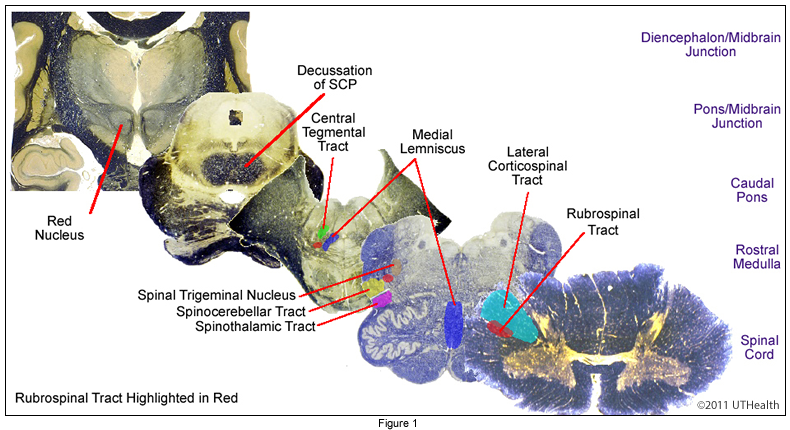Lab 6 (ƒ9) Descending Pathways to the Spinal Cord
The Rubrospinal Pathway - Overview
Many axons from the red nucleus decussate and collect to form the rubrospinal tract. While the rubrospinal tract descends to all cord levels, most rubrospinal fibers terminate in the cervical cord in the lateral part of the anterior horn. These fibers appear to control muscle tone and action of the muscles of the arm, hand, and fingers. They have an excitatory effect on the flexor muscles and an inhibitory effect on the extensor muscles.

The major inputs to the red nucleus include the cerebellum (interposed and dentate nuclei) and the cerebral cortex (motor and premotor areas). The band of fibers coursing towards the red nucleus lateral surface includes corticorubral fibers that arise in the cerebral cortex and terminate in the red nucleus. The fiber capsule surrounding the red nucleus includes the crossed superior cerebellar peduncle fibers that also terminate in this nucleus.
The position of the rubrospinal pathway changes as we move from the midbrain to the spinal cord; therefore, it is important to identify the pathway in relation to landmarks. In the figure, the pathway is shown in red in relation to some important structures.
The pathway starts at the red nucleus in the midbrain. As we move toward the pons, the pathway is shifted anteriorly by the decussation of the superior cerebellar peduncles (SCP). At this level, the fibers of the rubrospinal pathway are difficult to distinguish from the decussation of the SCP.
In the caudal pons, the pathway can be found in relation to the medial lemniscus and central tegmental tract. In the medulla, we find the rubrospinal pathway most easily anterior to the spinal trigeminal nucleus; however, we can also use the spino-cerebellar and thalamic tracts as references as well. Finally, in the spinal cord, the pathway can be found just anterior to and overlapping with the lateral corticospinal tract.
Keep these landmarks in mind as you try to identify the rubrospinal pathway in the next sections.
